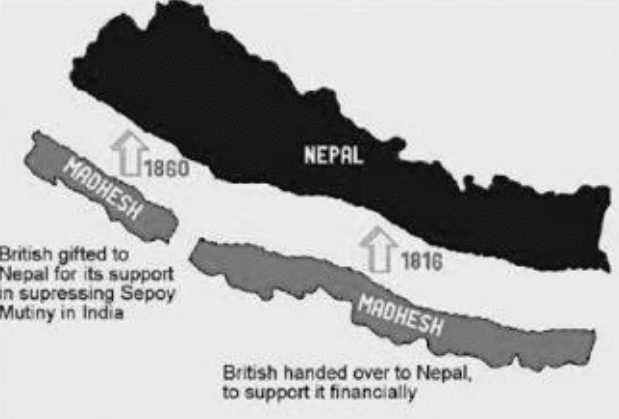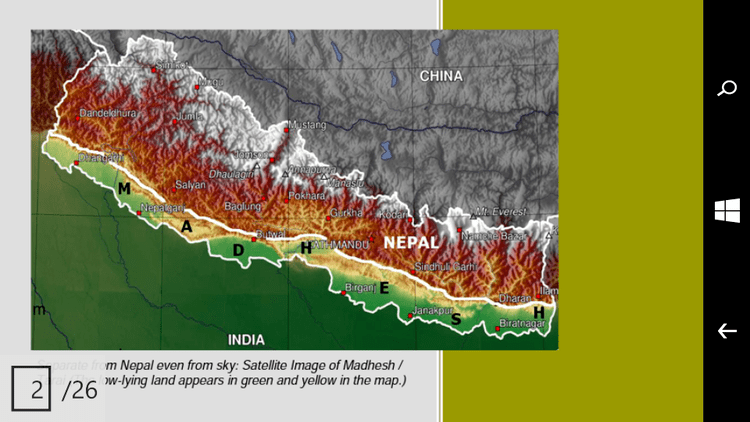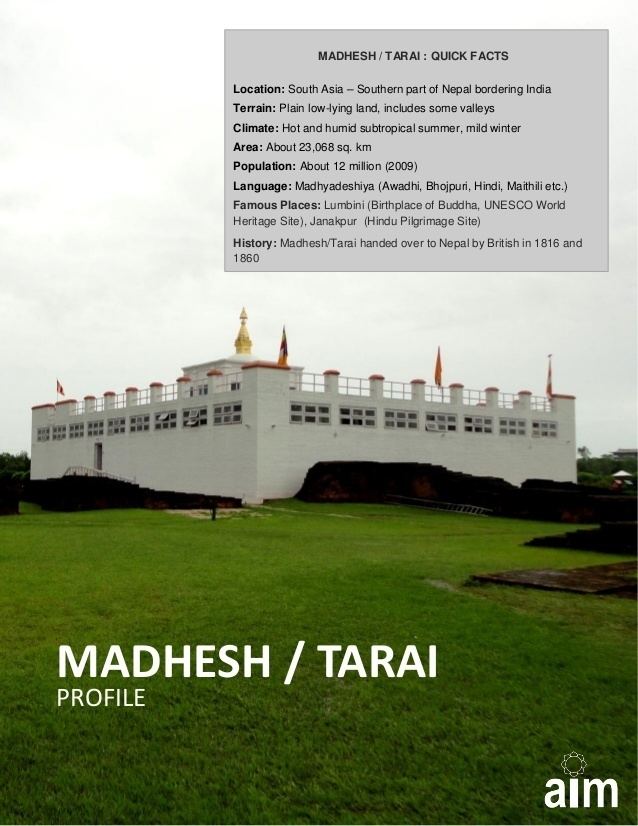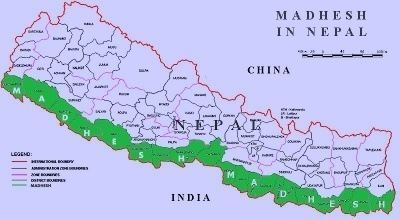J F M A M J | F M A M J J | |
 | ||
kp oli and madhesh
Madhesh is a fertile and humid region of southern Nepal in the Terai belt. The Nepali people who have cultural and demographic connection to Bihar and Uttar Pradesh of India and historically lived there are identified as Madhesi people. The region's name in Urdu as referred to by Muslims is ترای tarāī, meaning "lands lying at the foot of a watershed" or "on the banks of a river; low ground flooded with water, valley, basin, marshy ground, marsh, swamp; meadow".
Contents
- kp oli and madhesh
- Untold story of madhesh and nepal part1
- Region
- History
- Modern history
- Timeline
- Ethnic groups
- Economy
- Cuisine
- Tourism
- Notable people from Madhesh
- References

The eastern part of Madhesh and northern part of Bihar was part of the Mithila region and has been separate from Nepal historically. It was gifted to Nepal by the British as a reward for helping to suppress the 1857 rebellion of India. There is an ongoing movement for a "Free Mithila state" in Nepal.

The Alliance for Independent Madhesh is an organisation led by CK Raut that aims to gain secession for the region from Nepal.

Untold story of madhesh and nepal part1
Region
Nepal Government has differentiated some Terai region into "Outer" Madhesh and Inner Madhesh Valleys of Nepal.

The 2011 national census counted 2.3 million population (10% of the national total) lives in the inner Terai and 10.3 million population (45% of the national total) lives in the Outer Terai.
History

Madhesh is a Nepali morphological derivative of Madhyadesh (Sanskrit) or Majjhimadesh (Pali) and means the "Middle Country" signifying its location between the Himalayas and the plains. Terai (also written as Tarai) is presumed to be derived from Persian, meaning “damp”, and denotes the land at the foothills of mountains, often damp and swampy.
Modern history

The upper Terai region including Madhesh Chure region was heavily forested with Sal before heavy logging began in the 19th century, particularly for used as railroad sleepers of Indian railway by British Raj. Inner Madhesh valleys historically were agriculturally productive but endemic to malaria. Some parts were left forested by official decree during the Rana dynasty as a defensive perimeter. The British believed that plainsmen generally die if they sleep in the malaria-infested zone before November 1 or after June 1. British travelers to Kathmandu went as fast as possible from the border at Raxaul in order to reach the hills before nightfall. Until 1958, Madhesh residents (Terai people) as well as Indians were required to stop at the border town of Birgunj to obtain passports before proceeding to Kathmandu. Passports were then checked at Chisapani Garhi on the route to Kathmandu. Before 1951, one's nationality appears to have been determined primarily on linguistic basis. Nepalese subjects were the “hill folks” who spoke Nepali or hill languages such as Newari, Magar and Gurung etc. Thus, in early 1950s language was the major factor for separating as well as discriminating Madheshi as outsiders. Acquisition of land assets was linked to citizenship issues. After the fall of the Shah Dynasty and promulgation of the Interim Constitution of 2063, many Madheshi people received citizenship. Due to loose regulations, it is said that even many Indian nationals were able to get citizenship.
Timeline
Ethnic groups
Maithils, Tharu people, Bhojpuri, Awadhi, Kisan people, Dunuwars, Satar and some other ethnic communities are the first indigenous inhabitants of Terai. They have been living in the Terai for millennia, and reputedly have innate resistance to malaria. Following the malaria eradication program using DDT in the 1960s, a large and heterogeneous non-Tharu population namely refugees from the hills, Bhutan, Sikkim and other parts of India settled in the region.
Tharu people are scattered over most of the Terai, with several subgroups in the far-western and western Terai. A large Tharu populations resides in the central Terai. Kochila Tharus live foremost in the eastern Terai. Maithils inhabit eastern Madhesh, Bhojpuris are found in the centre and Awadhis inhabit the western part. The Eastern part of Madhesh was part of the Mithila region and has always been home to Maithili speaking people which is why some are proposing to rejoin Mithila in India. People from the mid-hills moved to the Terai plains including Brahmin, Chhetri and Newar during King Mahendra's rule in the name of flood victims, Mahendra highway construction, government officials. High caste migrants from the hills have purchased or otherwise got hold of large landholdings. Together with traditional Tharu landlords, they constitute the upper level of the economic hierarchy, which in the rural parts of the Terai is determined to a large extent by the distribution and the value of agriculturally productive land. The poor are the landless, or near landless, Madheshi Dalits, including the Musahar and Chamar, as well as the traditional fishermen, the Mallaah, and some of the Hill Dalits. In particular the Musahars rarely get other work than hard farm labor.
Economy
The Terai is the most productive region in Nepal, with the majority of the country's industries. Agriculture is the basis of the economy. Major crops include rice, wheat, pulses, sugarcane, jute, tobacco, and maize. In the eastern districts from Parsa to Jhapa they support agro-based industries: jute factories, sugar mills, rice mills and tobacco factories.
Mahendra Highway crosses the Terai from Kankarbhitta on the eastern border in Jhapa District, Mechi Zone to Mahendranagar near the western border in Kanchanpur District, Mahakali Zone. It is the only motor road spanning the country from east to west.
Cuisine
Madhesh is to food what the mountains are to snow. It is the most agriculturally productive region of Nepal – flat and fertile land, coupled with hot and humid weather – this region is perfect for farming. A surplus of rice, wheat, sugarcane, lentils and various other crops are produced in the Madhesh and transported to other parts of the country – the majority of what is eaten in the Valley comes from the Madhesh, the food granary of Nepal.
The veggie delight
The price of seasonal vegetables can be exceptionally low in the Madhesh. People in the Madhesh are blessed with vegetables; even the less fortunate families prepare three or four varieties as part of their meal. Perhaps this is the reason why gundruk (fermented vegetables) and Mashyauras (dried veggies), the beloved Nepali favorite, are less eaten in the Madhesh. Since vegetables are incredibly cheap and readily available in the Madhesh, deep-fried vegetable fritters called pakoras are commonly eaten; this crispy fritter is offered to guests, eaten as a snack or even with meals. In this region, people go beyond the regular onion and eggplant pakoras found elsewhere; Madheshis make an assortment of pakoras and pretty much any vegetable is cooked into a pakora, even green leaves.
Deliciously India Influenced
It is no surprise that the culinary culture in Madhesh is influenced by the adjacent regions of India, such as Bihar and Bhojpur, where roti (unleavened flatbread) is a staple food item. Likewise, everyday food in Madhesh encompasses a variety of whole grain flatbreads such as wheat roti, corn roti, all kinds of parathas (flatbread with stuffing), maduwa (barley flatbread) and litti (gram flour flatbread). Furthermore, special varieties of bread are prepared during festivals and feasts – for example, thekuwa (bread cum cookie made out of wheat flour and other ingredients) and bhusuwa (flatbread made out of rice flour as the main ingredient) are the two special festival treats prepared during Chaat, the biggest festival of Madhesh. Some other India-influenced dishes include malpuwa (sweet wheat fritter), dahi bara (lentil dumpling topped with a savory gravy of yoghurt, tamarind and spices) and mithais (sweets).
Madheshis are also known to prepare their food using relatively more spices and oil. Regardless of the excruciating heat, they like their food spicy. Ironically, Madheshis also seem to have a sweet tooth, as they consume a lot of mithais and sugarcane (which is extensively grown in the Madhesh). Mithais are an essential part of the culture and almost all families make it at home. Madhesis have a tradition of offering them to their guests – they are the symbol of their hospitality. In Madhesh, it seems like everything has a season, including mithais – for example, teel ko laddu (sesame seed ball cake) is specially prepared during the festival of Maghe Sankranti. The consumption of this laddu during Sankranti also has a scientific rationale. This festival falls in the winter and sesame seeds are believed to generate heat in the body. Similarly, kasar (rice flour laddu/ball cake) and lai (laddu made with puffed rice called muri) are a must for Chaat. These festival treats are offered to the gods and then eaten as prashad (god’s blessing). Since agriculture and animal farming are intimately linked to each other (at least in the traditional methods of farming) there is an ample amount of dairy products available in the Madhesh Region. Yoghurt is consumed every day for its digestive properties and cooling effects. On the other hand, Madheshis consume less animal meat as compared to people from the hills, the Himalayas and even the inner Terai. In village, people rarely eat chicken or buffalo meat. On the other hand, people consume atypical meat of pigeon and duck. Similarly, meat is a rare indulgence in Madheshi cuisine.
No Feast without Fish
While meat is not a favorite indulgence in Madhesh, inhabitants of both inner and outer Madhesh have a special affinity for fish. They eat a lot of fresh fish curries in the Madhesh. The topic of fish cannot be completed without the mention of Tharus, one of the indigenous ethnic groups of inner Madhesh, whose main food is fish and rice. Considering that most Tharu settlements are close to the river, this tribe has a special connection with fish. In Tharu culture, fish is quintessential – it is a must for weddings, ceremonies, festivals and other special occasions. Tharus live very close to nature and our food items are also derived from nature; it keeps an ecological balance. This eco-friendly tribe has a fascinating food culture. Most of Madheshi-Tharu dishes are rice based. Rice is molded into various shapes and steamed to make dhikari, an essential festival treat. Moreover, a special kind of sticky rice called anadi is steamed and served. Tharu food can be divided into two categories – ordinary everyday food consisting of rice, lentils, vegetables and fish, and special food items that are mostly prepared and consumed during feasts, festivals and other special occasions. Furthermore, some other special Tharu food items on the menu include pakuwa (barbecued meat), gughi (dried shrimp) and an assortment of tina (vegetables). But it is unfortunate that they are gradually disappearing from the diet of the original inhabitants. The younger generation are more inclined towards industrial food – primarily due to advertisements and the need for fastconvenient food. On the brighter side, the older generation still seems to be attached to their traditional cuisines. People has an emotional attachment with her traditional food – even when they are living abroad, they cook the same dishes that they would eat in the Madhesh. Madhesh cuisine has its own charm – the food is interesting, colorful and simply delicious.
